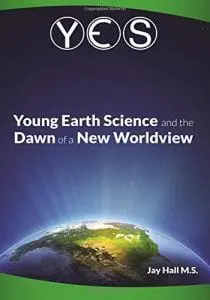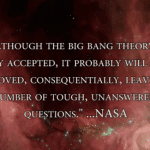Witness #5, Jay Hall, M.S.
In Parts 1-4, we called atheist Roger Lewin, agnostic Richard Milton, and creationists Don Boys, Ph.D, and Marvin Lubenow as witnesses against the reliability of radiometric dating. We have seen that the whole radiometric basis of dating rocks and fossils is a towering house of cards.
Our next and final witness against the reliability of radiometric dating is Jay Hall, M.S, from his book, “Young Earth Science & the Dawn of a New World View.”

I am certain that most people who encounter evolutionists’ claims that rocks and fossils have been reliably dated at millions or billions of years take it for granted that these assertions are the reporting of objectively determined facts. After all, the people saying such things are scientists. And scientists are merely objective reporters of fact, right? Yet, nothing could be further from the truth.
These assertions are interpretations based upon several extremely dubious assumptions, among which are the assumption that 1) all of the “daughter” elements of tested samples (e.g., lead from uranium, or argon from radioactive potassium) are the product of nuclear decay, 2) that there has been no leaching in or out of parent or daughter elements over the course of untold years, and 3) that the rates of radioactive decay of uranium and other radioactive elements are constant and invariable. Even many evolutionists have observed the doubtful nature of these claims. Both uranium and lead, for example, are extremely water soluble. Even rain causes extensive leaching. What would a worldwide flood do?
The third assumption, that the rates of radioactive decay are now and always have been constant throughout time, is regarded by many to be unquestionable, and evolutionists have claimed confidently and dogmatically that they are invariable. Yet, what is it that causes radioactive decay in the first place? And when have you ever heard an evolutionist ask this question? It is well known that the atomic forces within the atoms of radioactive elements are sufficient to prevent the escape of particles which constitute radioactive decay according to classical mechanics. The quantum wave function of particles is invoked by scientists to explain how radiation can happen. Even if we assume this to be true we can still ask, “Is that all there is to it?” Is there perhaps an external energy source that can interact with matter in such a way as to cause radioactive decay? I have had the suspicion for a long time that neutrino bombardment, especially solar neutrino production, is the primary source of the energy and catalyst of radioactivity.
Jay Hall, M.S. quotes Ian O’Neill at Discovery.com: on pg. 49-50 of Young Earth Science & the Dawn of a New World View
“…the decay rates of radioactive elements are changing. This is especially mysterious as we are talking about elements with ‘constant’ decay rates – these values aren’t supposed to change…This is the conclusion that researchers from Stanford and Purdue University have arrived at…The sun might be emitting a previously unknown particle [or neutrinos maybe] that is meddling with the decay rates of matter…researchers noticed the decay rates vary repeatedly every 33 days – a period of time that matches the rotational period of the core of the sun. The solar core is the source of solar neutrinos.”
For the reader not acquainted with neutrinos, neutrinos are a “slippery” ghost-like particle that almost never interacts with other matter. They pass right through the entire diameter of the earth and the other planets without perturbing their constituent elements or being affected by the matter they are passing through. According to a Wikipedia article:
“Most neutrinos passing through the Earth emanate from the Sun. About 65 billion (6.5×1010) solar neutrinos per second pass through every square centimeter perpendicular to the direction of the Sun in the region of the Earth.”
Yet every once in a while, about one in a trillion times, a neutrino will in fact collide with an atom adding energy and enabling particle escape, i.e., radiation.
Hall continues:
“Evidence based upon tree rings indicates that the solar cycle was just 7 years in the Post-Ice Age era in contrast to the current cycle of 11 years. Could more solar activity imply more rapid radioactive decay rates in the past? If the sun affects radioactive decay rates and the solar cycle was more frequent in the past, could this imply that radioactive decay was faster in the past? This planet may actually be youthful and not billions of years old.”—pg. 50
Hall is a young earth creationist. Evolutionists claim that Hall and other creationists are biased against evolution and are making bogus claims. Let us, therefore, hear what William D. Stansfield, Ph.D., a prominent, highly respected and strident anti-creationist and evolutionist has to say on the subject of radiometric dating and the assumptions upon which radiometric dating is conducted:
“If we assume that (1) a rock contained no Pb-206 [lead] when it was formed, (2) all Pb-206 now in the rock was produced by radioactive decay of U-238 (uranium), (3) the rate of decay has been constant, (4) there has been no differential leaching by water of either element, and (5) no U-238 has been transported into the rock from another source, then we might expect our estimate of age to be fairly accurate. Each assumption is a potential variable, the magnitude of which can seldom be ascertained…
“It is obvious that radiometric techniques may not be the absolute dating methods that they are claimed to be. Age estimates on a given geological stratum by different radiometric methods are often quite different (sometimes by hundreds of millions of years). There is no absolutely reliable long-term radiological ‘clock.’ The uncertainties inherent in radiometric dating are disturbing to geologists and evolutionists, but their overall interpretation supports the concept of a long history of geological evolution. The flaws in radiometric dating methods are considered by creationists to be sufficient justification for denying their use as evidence against the young earth theory.”—The Science of Evolution, pg. 83-84
Indeed, we do. Note well that Stansfield acknowledges that it is an assumption that radioactive decay rates are invariable. Stansfield is essentially saying here, “I acknowledge the extreme unreliability of radiometric dating to the tune of hundreds of millions of years but I choose to have faith in it, anyway.” We have seen in previous articles that the unreliability of radiometric dating actually extends to billions of years, and this is all a highly selective process anyway in which the scientists discard more results than they accept! So much for their belief in the reliability of radiometric dating!
Hall cites physicist H. C. Dudley:
“…induced changes in disintegration rates of 14 radionuclides [have been investigated], including C-14, Co-60, and Cs-137. The observed variations in the decay rates…were produced by changes in pressure, temperature, chemical state, electric potential, stress on monomolecular layers…These findings, together with complex and alternative disintegration modes, by which certain radionuclides decay ([e.g.] Cu-64, β-, β+ or electron capture) have led to the conclusion that…The decay ‘constant’ is now considered a variable.”—pg. 59, quote from The Morality of Nuclear Planning, pg. 53, emph. supp.
Hall also points out that the accepted decay rate of Samarium-146 has recently been changed from 103 ± 5 million years to 68 ± 7 million years and “ultrasonic cavitation of water increases thorium decay by a factor of ten thousand.”—pg. 59
And Again:
“Paul Renne et al wrote an interesting paper in Science, ‘Absolute Ages Aren’t Exactly.’ There are significant uncertainties in the decay rates of various isotopes. In fact, geochronologists and nuclear physicists often use different decay rates.”—pg. 63, Young Earth Science & the Dawn of a New World View
And this:
“…the decay rate of chlorine-36 increases as Earth approaches the sun…Such discrepancies might be explained if a neutrino somehow amplifies the decay rates…if solar neutrinos transferred a mere millionth of their energy to a decaying nucleus, that might have a big effect on the rate at which it breaks up…whatever process generated the flare in 2006 also caused a dip in neutrino flux, and a corresponding drop in radioactive decay rates…For example, a storm in 2008 was preceded by a spike in manganese-54 decay rates.” Pg. 65, Young Earth Science & the Dawn of a New World View, quoting The Economist
This should be sufficient to establish the point that the supposed invariability of radioactive decay rates is, in the final analysis, an article of faith contrary to the data on the part of evolutionists who need long ages to prop up failed evolutionary dogma and their religion of Naturalism. There is much, much more that could be cited in this regard. Henry Morris has also compiled a long list of such quotations from evolutionists in his book, That Their Words May be Used Against Them, subtitled, Quotes From Evolutionists Useful for Creationists.
Evolutionists cite radiometric dating results as the most important, and supposedly most reliable, dating technique of rocks and fossils. Upon radiometric dating stands the evolutionists case for very ancient ages of rocks, fossils and the Earth itself. In this series, we have considered 1) empirical proof of the unreliability of radiometric dating in its use on lava rock of known ages, 2) the foundation of extremely unlikely assumptions upon which radiometric dating rests, and 3) empirical findings demonstrating that the radioactive decay rates themselves can be altered both in the laboratory and by natural forces and processes. All of these considerations add up to a proverbial mountain of evidence against the reliability of radiometric dating.
In my next article, “THE UN-FOSSILS – SOFT DINOSAUR TISSUE,” we will turn to the subject of the astounding discovery of extant soft dinosaur tissue, dinosaur DNA finds including unracemized DNA, and extant Carbon-14 in original dinosaur tissue.








Is it even necessary for radiometric decay to be influenced by neutrinos?
It is well known that fast neutrons cause fission. A hidden assumption in radiometric dating is that there is uniformitarianism (no abrupt spikes) in sources for fast neutrons. A nearby supernova can produce gamma rays (fast moving electrons), cosmic rays (mostly very fast moving protons), and very fast neutrons. In fact the light produced is only a tiny fraction of the energy released. If a very close by supernova (much less than 1000 light years) happened in conjunction with the flood, then a high dose of neutrons would have greatly accelerated radiometric decay. There is also recent research that deduces that increases in cosmic rays during extended solar minimums cause volcanoes with high silica magma to erupt. Which then implies a lot of volcanic activity during the flood caused by a nearby supernova. Another paper documents a certain slowly decaying isotope of iron found in seabed sediments which is conjectured to come from supernovas. There seems to be a lot of indirect evidence for a nearby supernova during the flood. We have not had one for more than 100 years. Another scientist has predicted a nearby supernova for 2022 +/- a year. So if this happens, we will have an opportunity to actually scientifically measure one, and see what the effects are if any on earths climate, volcanic activity, number of earthquakes, and radiometric decay.
Here is a link to a secular paper which details some of the effects of a nearby supernova.
https://hal.archives-ouvertes.fr/hal-01699566v1/document
I forgot in my first response to include links to David LaPoint’s three videos on Primer Fields. They are a little cumbersome to get through but well worth the effort. Check’em out: https://www.youtube.com/watch?v=9EPlyiW-xGI&t=26s&ab_channel=DavidLaPoint AND: https://www.youtube.com/watch?v=2NogyJ0k8Kw&t=3380s&ab_channel=DavidLaPoint AND: https://www.youtube.com/watch?v=lpI6ikj1G-s&t=1578s&ab_channel=DavidLaPoint
Well, Jim, in a word: No. Neutrinos need not necessarily be invoked. I think they do play a part but not necessarily the whole part, nor necessarily the most significant part. The truth is that radioactive decay is NOT UNDERSTOOD. Moreover, modern cosmology, astronomy, and astrophysics is in a state of extreme chaos. There is not a week that goes by in which astronomers and astrophysicists don’t announce in peer-reviewed journals their utter surprise at the findings of astronomy and astrophysics. Yet basic assumptions are never questioned. Rescuing devices are multiplied ad infinitum. Fictitious entities like dark matter and dark energy are invoked continually as rescue devices for failed theories. It is time for a major overhaul.The Zero Point Energy of the universe almost certainly has a lot to do with the RATE at which radioactivity and atomic processes have slowed down over the last six thousand years since creation. Your should read Barry Setterfield’s “Cosmology and the Zero Point Energy” (https://www.amazon.com/Cosmology-Point-Energy-Setterfield-2013-08-02/dp/B01K3KXWKQ/ref=sr_1_1?s=books&ie=UTF8&qid=1529407729&sr=1-1&keywords=Cosmology+and+the+zero+point+energy&dpID=51Pm0PJ4YqL&preST=_SX258_BO1,204,203,200_QL70_&dpSrc=srch). One of the best sources documenting the failure of modern astrophysics is a secular source, the people at the Electric Universe group, a group advocating plasma physics as the most fundamental controlling force, and I have no doubt whatsoever that they are correct on this point. Chedck’em out. They are prolific producers of well-produced videos and have currently 289 videos exposing the pretensions of institutional astrophysics in their “Space News” section. I don’t buy into much of the “historical reconstruction” of the group but I think their physics is dead on. Check’em out: https://www.youtube.com/results?search_query=electrfic+universe+space+news. And while you are at it, a MUST read is Halton Arp’s book, “Seeing Red: Redshifts, Cosmology and Academic Science.” If you are not familiar with Arp, he is the astrophysicist who definitively debunked the Big Bang delusion with OBSERVATIONAL science: https://www.amazon.com/Seeing-Red-Redshifts-Cosmology-Academic/dp/0968368905/ref=sr_1_1?s=books&ie=UTF8&qid=1529407820&sr=1-1&keywords=seeing+red+halton+arp&dpID=414pIcNKkRL&preST=_SY291_BO1,204,203,200_QL40_&dpSrc=srch.